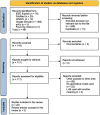Applications of generative artificial intelligence in outcome prediction in intensive care medicine-a scoping review
- PMID: 40837819
- PMCID: PMC12361121
- DOI: 10.3389/fdgth.2025.1633458
Applications of generative artificial intelligence in outcome prediction in intensive care medicine-a scoping review
Abstract
When a patient survives the first 24 h in intensive care, outcome prediction is crucial for further treatment decisions. As recent advances have shown that Artificial Intelligence (AI) outperforms clinicians in prognostication, and especially generative AI has developed rapidly in the past ten years, this scoping review aimed to explore the use of generative AI models for outcome prediction in intensive care medicine. Of the 481 records found in the search, 119 studies were subjected to abstract screening and, when necessary, full-text review for eligibility assessment. Twenty-two studies and two review articles were finally included. The studies were categorized into three prototypical use cases for generative AI in outcome prediction in intensive care: (i) data augmentation, (ii) feature generation from unstructured data, and (iii) prediction by the generative model. In the first two use cases, the generative models worked together with downstream predictive models. In the third use case, the generative models made the predictions themselves. The studies within data augmentation either fell into the area of compensation for class imbalances by producing additional synthetic cases or imputation of missing values. Overall, Generative Adversarial Network (GAN) was the most frequently used technology (8/22 studies; 36%), followed by Generative Pretrained Transformer (GPT) (7/22 studies; 32%). All publications except one were from the last four years. This review shows that generative AI has immense potential in the future, and continuous monitoring of new technologies is necessary to ensure that patients receive the best possible care.
Keywords: comorbidity; critical care; generative adversarial network; large language model; mortality; survival.
© 2025 Stamm, Bader-El-Den, McNicholas, Briggs and Zhao.
Conflict of interest statement
The authors declare that the research was conducted in the absence of any commercial or financial relationships that could be construed as a potential conflict of interest. The author(s) declared that they were an editorial board member of Frontiers, at the time of submission. This had no impact on the peer review process and the final decision.
Figures
Similar articles
-
Prescription of Controlled Substances: Benefits and Risks.2025 Jul 6. In: StatPearls [Internet]. Treasure Island (FL): StatPearls Publishing; 2025 Jan–. 2025 Jul 6. In: StatPearls [Internet]. Treasure Island (FL): StatPearls Publishing; 2025 Jan–. PMID: 30726003 Free Books & Documents.
-
Comparison of Two Modern Survival Prediction Tools, SORG-MLA and METSSS, in Patients With Symptomatic Long-bone Metastases Who Underwent Local Treatment With Surgery Followed by Radiotherapy and With Radiotherapy Alone.Clin Orthop Relat Res. 2024 Dec 1;482(12):2193-2208. doi: 10.1097/CORR.0000000000003185. Epub 2024 Jul 23. Clin Orthop Relat Res. 2024. PMID: 39051924
-
AI in Medical Questionnaires: Scoping Review.J Med Internet Res. 2025 Jun 23;27:e72398. doi: 10.2196/72398. J Med Internet Res. 2025. PMID: 40549427 Free PMC article.
-
Health Care Social Robots in the Age of Generative AI: Protocol for a Scoping Review.JMIR Res Protoc. 2025 Apr 14;14:e63017. doi: 10.2196/63017. JMIR Res Protoc. 2025. PMID: 40227846 Free PMC article.
-
Signs and symptoms to determine if a patient presenting in primary care or hospital outpatient settings has COVID-19.Cochrane Database Syst Rev. 2022 May 20;5(5):CD013665. doi: 10.1002/14651858.CD013665.pub3. Cochrane Database Syst Rev. 2022. PMID: 35593186 Free PMC article.
References
-
- Haines KJ, Hibbert E, McPeake J, Anderson BJ, Bienvenu OJ, Andrews A, et al. Prediction models for physical, cognitive, and mental health impairments after critical illness: a systematic review and critical appraisal. Crit Care Med. (2020) 48:1871–80. 10.1097/CCM.0000000000004659 - DOI - PMC - PubMed
Publication types
LinkOut - more resources
Full Text Sources
Research Materials
Miscellaneous




